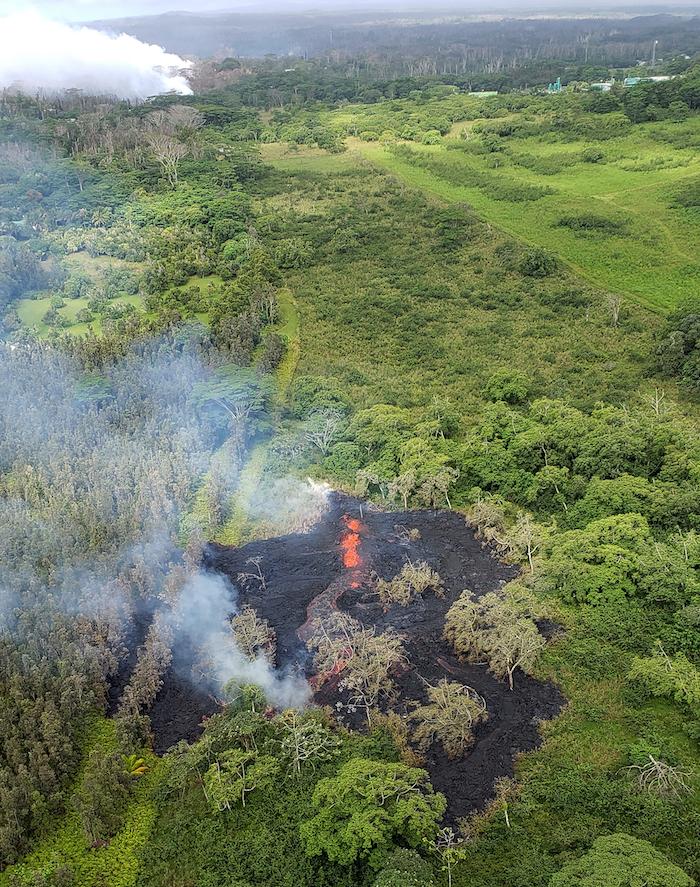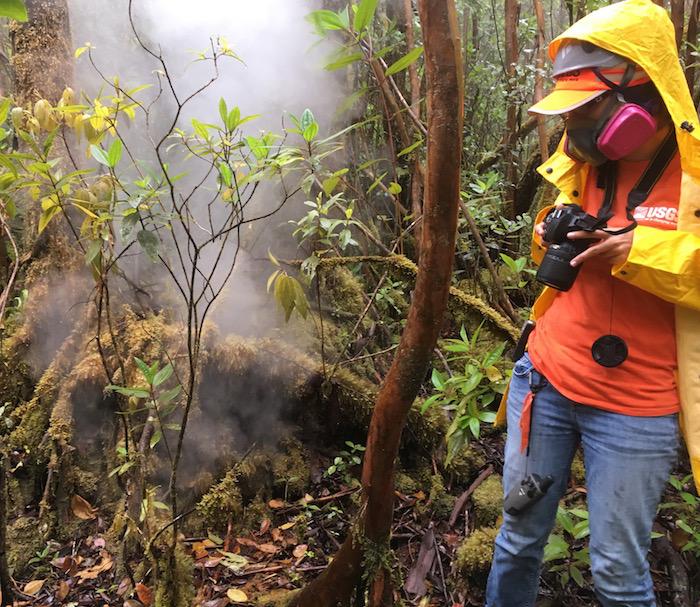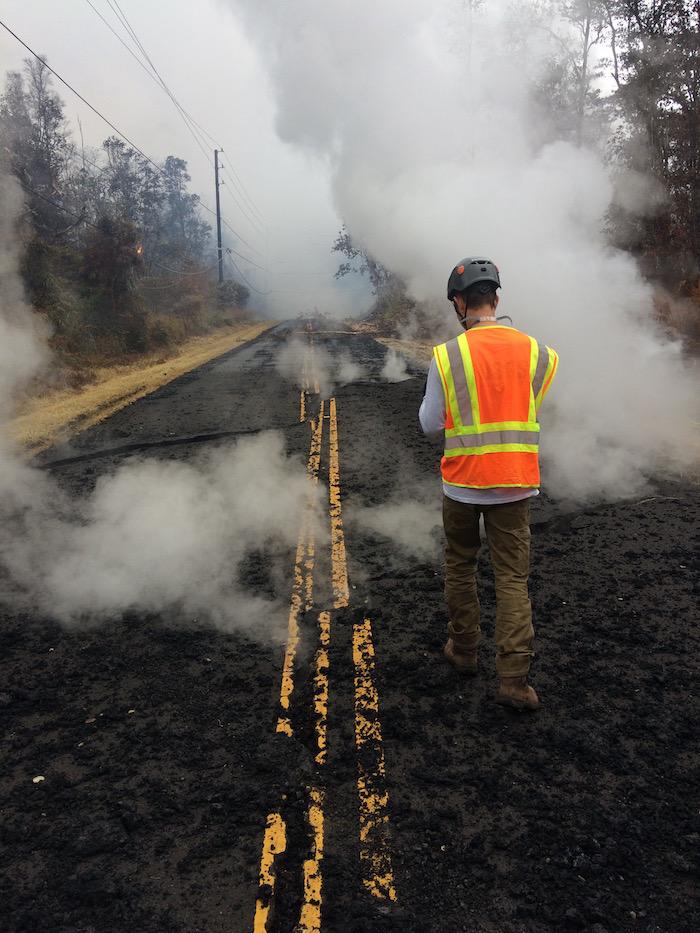
Fissure 16 was spotted Saturday morning, local time, near Hawai'i Volcanoes National Park/U.S. Geological Survey
For those of you planning (or who have already planned) a trip to Hawai’i Volcanoes National Park, I’ll bet, right about now, you are wondering just how long this Kīlauea Volcano eruptive activity is going to continue. Is this going to affect all of the Big Island and maybe even the entire state of Hawaii? Is your national park vacation totally ruined?
After all, the majority of this park is closed to all but critical staff at the Hawaii Volcano Observatory, which is located right on the rim of the volcano, next to Jaggar Museum. And, speaking of the skeleton staff there, what on earth kind of emergency evacuation response plan do those people have and how quickly can they predict when to put that plan into action? The answers received to some of these questions during the dial-in media briefing held Saturday afternoon were not all that concrete.
The briefing began with an update of the day’s situation: a new fissure (Fissure 16) opened up that morning at 6:45 a.m. Hawaii Standard Time (12:45pm EDT), about a mile northeast of Fissure 15 (near Lanipuna Gardens). Fissure 16 was considered to be “so small” that they weren’t even sure they could call it a fissure (defined in the dictionary as “a long, narrow opening or line of breakage”), but there was “some (lava) spattering,” and it’s about eight-tenths of a mile east-southeast of the Puna Geothermal Venture (PGV) plant. No information was given on how any of this might affect the PGV.
After the current activity report, a “nuts and bolts update” was given regarding the NPS Incident Management Team comprised of national park staff, the number of visitors to the park on that last day before the park closed (2,692), and the temporary flight restriction the Federal Aviation Administration has put into effect until May 25th, restricting flight above the summit crater Halema’uma’u extending 20,000 feet above the crater and 12 nautical miles out.
Questions ranged from details about SO2 monitoring, dispelling rumors running rampant, clarifying how much of the state this eruption event affects to, oh yeah, my questions regarding how long they think this activity will last and what kind of evacuation plans are in place for the few people remaining at the observatory within the park.
Questions/answers In a nutshell:
What kind of SO2 monitoring is taking place?
SO2 (Sulphur dioxide) is a toxic gas that can be emitted by volcanic activity. The Hawaii Volcanoes website indicates sites within the national park are being monitored for SO2 emissions, but none of the speakers would answer whether or not there was monitoring along the east rift zone. Janet Babb, a geologist with the observatory, said that the county had engaged the National Guard to do some monitoring, but there was no data available for them, at the time of this briefing.
Is there a threat of the Hilina Slump collapsing, causing a catastrophic failure of Kilauea’s south flank and thereby creating a tsunami?
In layman’s terms, the Hilina Slump is a chunk of land on the south flank of Kilauea volcano that has been slowly sliding southward at about 10 centimers per year. There is a UC Berkeley blog post, dated May 7th, about this slump that has “gone viral,” according to one of the call-in questioners. The gist of the blog post is that if a catastrophic eruption event occurred triggering a huge displacement of this slump, a magnitude 9 quake could be generated, along with a mega-tsunami having an estimated wave height of more than 1,000 feet.
Wendy Stovall, USGS vulcanologist and deputy scientist-in-charge for the Yellowstone Volcano Observatory, said there was not that much change to this slump during the current volcanic activity. She added that they are not expecting this Kilauea incident to be a catastrophic event like the 1924 eruption, and this was “not going to be the size or extension of the 1980 Mount St. Helens explosion, that they know of, right now.”

A USGS geologist photographs a steaming crack about 164 feet west of Highway 130 on Thursday, May 10, 2018, in an area of earlier cracking/U.S. Geological Survey
Is the Hawaii volcano going to affect other volcanoes around the world and cause the Ring of Fire to “go up”?
No. There is no connection of Kilauea to other volcanoes around the world. Yes, the Ring of Fire is a very active area and Hawaii just so happens to be a hotspot in the middle of this area, but no, it does not have any bearing on other volcanic activity around the world.
How long to they expect this volcanic activity to continue? The 1924 eruption event lasted a little under 3 weeks.
They will continue to monitor the situation – could be longer, could be shorter (than the 3 weeks of the 1924 eruption). It depends upon the magma supply and amount of steam that continues coming out of the volcano. This was my question and I don’t feel they really gave a direct answer, which leads me to believe they just aren’t certain how long this particular volcanic event will last.
Is it safe to come to Hawaii for a vacation?
This volcanic hazard is “pretty localized to just Kilauea” and not the rest of the island or the rest of the state. So, in effect, you can still come on over, but you just can’t visit most of Hawai’i Volcanoes National Park right now.
Is commercial aviation affected by this event?
Aside from the current FAA temporary flight restriction, both airports are up and running. It’s all dependent upon the amount of ash in the air and the direction of the wind. Both airports (Hilo International Airport and Ellison Onizuka Kona International Airport) are some distance north of the national park. The wind *could* blow ash in such a way as to impact airplanes taking off and landing, but it will be both the FAA and local airport’s decision as to whether to close the airport for a time in order to get any ash off the runway – and, again, that’s if any ash falls there in the first place.

Road cracks and volcanic vog photographed last week in Leilani Estates near Hawai'i Volcanoes National Park/USGS
What kind of emergency evacuation is planned for those people remaining at the Hawaii Volcano Observatory, right next door to the Jaggar Museum on the edge of Kilauea’s crater (technically, it’s on the rim of Kilauea Caldera overlooking Halema’ uma’ u Crater).
For a moment, all I heard on the other end of the line was silence. Then, a hesitant “is this a NPS question or a USGS question?” I responded it was a question for anybody who could answer it. In response, Leslie Gordon, a USGS public affairs specialist, informed us that the observatory has its own evacuation plan (yes, I knew that) and that the staff was at a minimum because scientists wanted as few people there as possible; only critical staff. And that was it for my answer, except the repeated statement that the majority of the park is closed, except for the Kahuku Unit, about an hour away from the main park. I honestly didn’t think my two little questions were that difficult.
So, there you go.
Just one more thing, which I certainly didn’t think to ask this at the time, and nobody else did, either: Mauna Loa is right next door to Kilauea, and yet none of the speakers mentioned anything about this great shield volcano. What makes it so different and so separate that it would not be affected in some way by the shenanigans of Kilauea? I think, if given the chance, I might just ask that question during the next media briefing.



Comments
Thanks for this update, Becky.